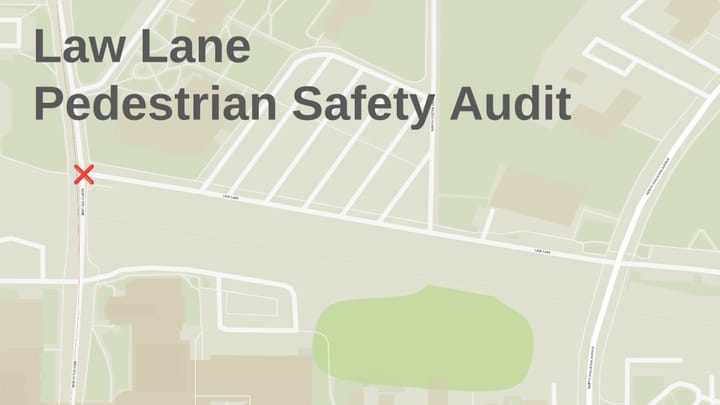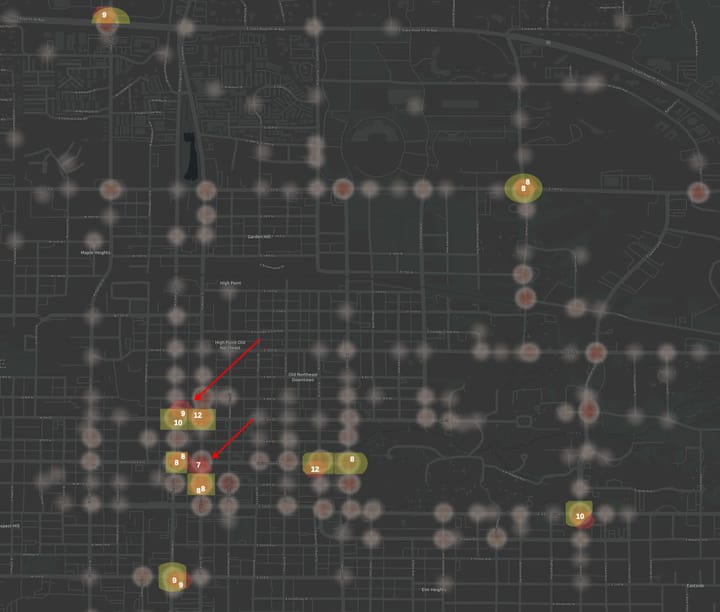Why is biking not recommended on sidewalks, but is on multi-use paths?

Plenty of bike advocates will recommend against biking on sidewalks, but at the same time will recommend biking on multi-use paths. Both are often next to roads and intersect with roads. So what's the safety difference between biking on a sidewalk on a multi-use path? Other similar bike facility terms are cycle track, separated bike lane, protected bike lane or sidepath.
Let's look at some differences:
- Number of conflict points. A conflict point is any time the bike facility crosses another facility where the paths could conflict and result in a crash, such as a driveway or intersection. A sidewalk along a block may cross every driveway along the block, so there many conflicts points. A cycle track or protected bike lane across the same block should be designed to minimize the conflict points.
- Width. A multi-use path is designed to be wide enough for a cyclist to comfortably and safely pass a pedestrian, while typical sidewalks are not.
Should you bike on the sidewalk in some cases?
I live in Bloomington, Indiana which recently passed a law to legalize biking on sidewalks in some cases. If sidewalk riding is more dangerous than multi-use paths, why legalize it?
Sometimes riding on a sidewalk is the safest option. There are places here where the options are riding in a busy street with fast car traffic, or riding on an empty sidewalk. Navigating the rare pedestrians and the conflict points of the sidewalk may be the safest option. Legalizing biking on the sidewalk in those cases decriminalizes people getting where they are going without a car in the safest way.
The law that allows bikes on sidewalks is written to prioritize pedestrians using the sidewalks. In places where there is usually particularly high pedestrian traffic, bikes on sidewalks are not allowed at all.
Wherever you bike, be mindful when crossing conflict points and yield to pedestrians in shared facilities.
Bloomington, Indiana law for operating bicycles on sidewalks
Here's how the Bloomington, Indiana code for operating bicycles is written. This is section 15.56.020 from our municipal code:
- A person operating a bicycle on a sidewalk, multiuse path, multiuse trail, or within a crosswalk, shall yield the right-of-way to any pedestrian.
- A person who is operating a bicycle and who is passing a pedestrian traveling on the same facility shall pass the pedestrian at a distance of at least three feet. If a bicycle operator is unable to pass the pedestrian at a distance of at least three feet, then the bicycle operator shall stop, dismount, or exit the facility.
- A person operating a bicycle upon a sidewalk, multiuse path, multiuse trail, or within a crosswalk, before overtaking a person with a visual impairment who is carrying a white cane or who is guided by a service animal, shall dismount and pass on foot, if necessary to avoid startling, inconveniencing or colliding with the person.
- A person operating a bicycle shall give an audible signal before overtaking and passing any pedestrian while traveling in the same direction and on the same facility as the pedestrian. The audible signal may be given by voice or by bell or other warning device capable of giving an audible signal and shall be given at such a distance and in such a manner as to not startle the person or persons being passed.
- A person operating a bicycle on a sidewalk, multiuse path, multiuse trail, or within a crosswalk shall not suddenly move into the path of a vehicle or pedestrian so as to constitute an immediate hazard.
- No person shall operate a bicycle on a sidewalk, multiuse path, or multiuse trail at a speed greater than ordinary pedestrian activity when approaching or entering a crosswalk, or approaching or crossing a driveway or alley if a vehicle is approaching the crosswalk or driveway close enough to constitute a potential hazard.
- Operating a bicycle on the sidewalks and within the crosswalks along the following streets is hereby declared a public nuisance and is therefore prohibited. Bicyclists in these areas shall dismount their bicycles. Signage shall be in place prior to enforcement of this requirement and shall, when practicable, be in the form of markings on the sidewalk.
STREETS:
- Fourth Street from Indiana Avenue to the B-Line Trail.
- Kirkwood Avenue from Indiana Avenue to the B-Line Trail.
- Sixth Street from Indiana Avenue to the B-Line Trail.
- Indiana Avenue from Fourth Street to Seventh Street.
- Dunn Street from Fourth Street to Seventh Street.
- Grant Street from Fourth Street to Seventh Street.
- Lincoln Street from Fourth Street to Seventh Street.
- Washington Street from Fourth Street to Seventh Street.
- Walnut Street from Fourth Street to Seventh Street.College Avenue from Fourth Street to Seventh Street.



Comments ()